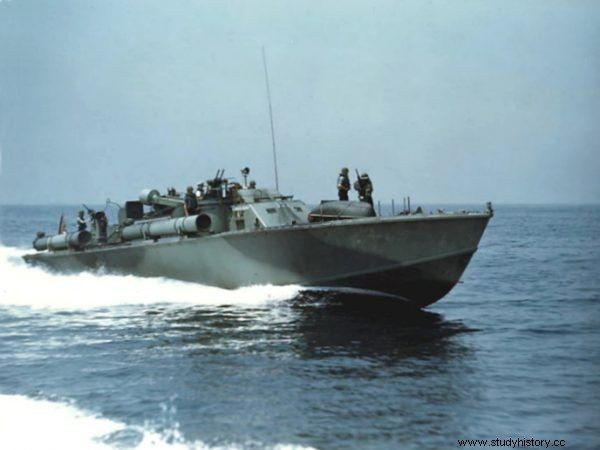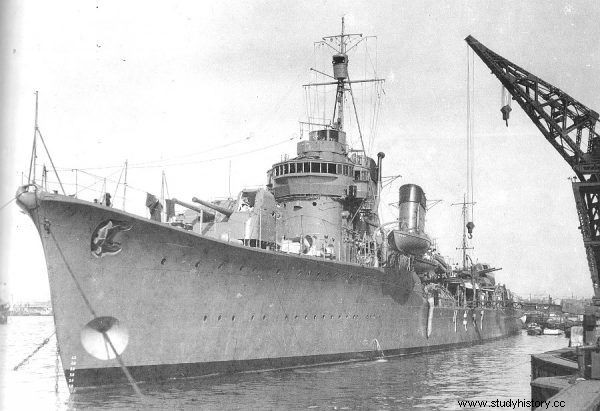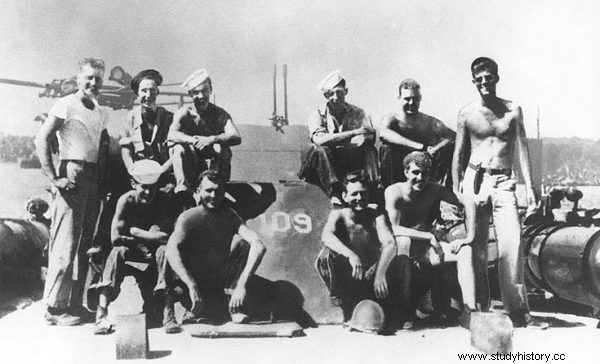During the Pacific War, John F. Kennedy fought as the captain of a torpedo boat. Rammed by a Japanese destroyer, it brushed to death in the waves… and secured a good start in his political career. The US presidency became its culmination.
Torpedo boats type PT (PT - Patrol Torpedo ) are small warships used for a multitude of tasks: carried commanders, mail and spies, rescued pilots of downed planes, attacked Japanese supply convoys and fought submarines . The Americans produced just over 600 of them during World War II.
The commander of one of these boats was John F. Kennedy, the future US president, then in the rank of second lieutenant. In the summer of 1943 he was a captain on the PT-109 and served in the vicinity of the Solomon Islands. He participated in a mission to stop a Japanese convoy in the Blackett Strait within the archipelago.
Disaster
On the night of August 1-2, 15 PT cutters attacked 4 Japanese destroyers, three of which were used as transporters. 30 torpedoes were launched, but none of them managed to damage the enemy ships . As if that was not enough, in complete darkness Kennedy's cutter was rammed by destroyer Amagiri.

A young John F. Kennedy (Photo:Naval History and Heritage Command, public domain) served on such a cutter.
The forty-ton wooden-hulled ship did not stand a chance with the steel one, having over 2,000. tons of buoyancy opponent. The cutter was halved and two crew members were killed. The eleven survivors, including the two wounded, had no choice but to swim on their own to one of the islands. Since most of them were Japanese outposts, they chose the uninhabited Kasolo Island 5.6 km away, now called Kennedy Island.
The future president towed heavily injured Patrick McMahon all the way, reportedly clutching a belt in his teeth. Their seven companions took turns pushing the clinging boards of two non-swimmers. Kennedy was the first to reach his destination, but he was so exhausted that McMahon had to help him get onto the beach.
Later that night, the commander of the survivors set sail again, hoping that he would meet American boats there. The expedition almost cost him his life as strong currents carried him far from his destination. Upon his return, he slept all day, but had previously sent one of his subordinates on a similar mission. Again, no help could be found.
In search of salvation
On August 4, 11 survivors decided to search for water and food further south and sailed to Olasana Island. There were coconuts, but made some Americans sick. There was no water. On June 4, Kennedy and Ensign Ross sailed to Naru Island, where they found the wreckage of a small Japanese boat, a candy can, and a water tank, and a canoe. At the wreckage, they encountered two natives, but they quickly escaped.
The next day, Kennedy returned to Olasana with candy and water, where he discovered that the islanders met on Naru had made contact with the remaining survivors. Biuku Gas and Eroni Kumana, because that was the name of the newcomers, were fortunately Allied scouts .
The future president returned with them to Naru for Ross, and then decided to send them with a message to the nearest allied post.

The PT-109 crew noticed destroyer Amagiri 10 seconds before the impact (photo:Shizuo Fukui, public domain).
He engraved a request for help on a coconut shell, and its content can be found in the book "Unforgettable Letters":
NAURU ISLAND COMMAND
TUBE KNOWS LOCATION
CAN PILOT 11 LIVE
SMALL BOAT NEEDS
KENNEDY
Delivering the package was not easy:Japanese patrols were abundant in the surrounding waters, and islanders caught helping the Allies were tortured and killed. Nevertheless, they managed to reach the post of Australian coast guard Arthur Reginald Evans, who radioed the American base on Rendowa Island and sent the survivors water and food.

Kennedy made a mistake in the name of the island:it was not much larger Nauru, but Naru (Photo:John F. Kennedy Presidential Library and Museum, public domain).
On August 7, the natives hid Kennedy in a canoe under palm leaves and transported him to Evans' station. From there, the future president sailed to meet two fishing boats sent from Rendowa to find the survivors. He wanted to personally pilot the ships on a rescue mission.
When the boats reached Olasana in the morning on August 8, all the Americans waiting there were asleep. Exhausted Kennedy, who had drunk some "medical brandy" earlier, started shouting at his subordinates , raising concerns about alerting the Japanese.
Heroic President
After the successful end of these adventures, Kennedy commanded the PT-59 cutter and that same year saved a group of American Marines from a sinking landing barge. For his actions, he was awarded the Navy and Marines Medal and the Purple Heart awarded to soldiers wounded in battle.

Second Lieutenant John F. Kennedy (standing right) with his crew in 1943 (photo from the collection of the U.S. National Archives, public domain),
The story of the survivors of the PT-109 was reported by John Hersey in The New Yorker and Reader's Digest. This opened the way for Kennedy to a later political career. The future president ordered a coconut shell framed with the message he scratched out and used it later as a paperweight. When asked in 1959 how he became a hero, he replied, “It was easy. They sank my ship. ”
Biuku Gas and Eroni Kumana remained rather forgotten for a long time . It was only in 2002 that the National Geographic team, which was looking for the PT-109 wreck, found them. The two met with the Kennedy family who paid to build their homes. The first one died in 2005, the second one in 2014.
